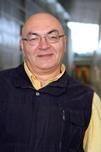
Yuri P Danilov
University of Wisconsin, USA
Title: New approach to Neurorehabilitation: Cranial nerve noninvasive neuromodulation (CN-NINM technology)
Biography
Biography: Yuri P Danilov
Abstract
Cranial-Nerve Non-Invasive NeuroModulation (CN-NINM) is a primary and complementary multi-targeted rehabilitation
therapy that initiates the recovery of multiple damaged or suppressed brain functions that are aff ected by neurological disorders.
CN-NINM was originally developed in our lab to facilitate and enhance the brain's innate ability to reorganize and “normalize”
its functional activity during targeted physical and occupational therapy, and thus improve movement control and cognition. It is
deployable as a simple, home-based device (portable tongue neurostimulator, PoNSTM) and training regimen following initial patient
training in an outpatient clinic. It may be easily combined with all existing rehabilitation therapies, and may reduce or eliminate need
for more aggressive invasive procedures or decrease the total medication intake.
CN-NINM uses sequenced patterns of electrical stimulation on the tongue. Our hypothesis is that CN-NINM induces
neuroplasticity by noninvasive stimulation of two major cranial nerves: trigeminal, CN-V, and facial, CN-VII. Th is stimulation excites
a natural fl ow of neural impulses to the brainstem (pons varolli and medulla), and cerebellum via the lingual branch of the cranial
nerve (CN-Vc), and chorda tympani branch of CN-VII, to eff ect changes in the function of these targeted brain structures, extending
to corresponding nuclei of the brainstem – at least in the sensory and spinal nuclei of trigeminal nuclei complex and the caudal part
of the nucleus tractus solitarius. We postulate that the intensive activation of these structures initiates a sequential cascade of changes
in neighboring and/or connected nuclei by direct collateral connections, brainstem interneuron circuitry and/or passive transmission
of biochemical compounds in the intercellular space. Combining neurostimulation with a specifi c set of physical, cognitive and/or
mental exercises we can further focus brain rehabilitation and target our eff ort on recovery of selected functional damage. Th e result is
essentially brain plasticity on demand – a priming or up-regulating of targeted neural structures to develop new functional pathways,
which is the goal of neuro-rehabilitation and a primary means of functional normalization and recovery.
CN-NINM represents a synthesis of a new non-invasive brain stimulation technique with applications in physical medicine,
cognitive, and aff ective neurosciences. Our new stimulation method appears promising for treatment of a full spectrum of movement
disorders, and for both attention and memory dysfunction associated with traumatic brain injury. Th e integrated CN-NINM therapy
proposed here aims to restore function beyond traditionally expected limits by employing both newly-developed therapeutic
mechanisms for progressive physical and cognitive training - while simultaneously applying brain stimulation through a portable
neurostimulation device. Based on our previous research and recent pilot data, we believe a rigorous in-clinic CN-NINM training
program, followed by regular at-home exercises that will also be performed with CN-NINM, will simultaneously enhance, accelerate,
and extend recovery from multiple impairments (e.g. movement, vision, speech, memory, attention, and mood), based on divergent,
but deeply interconnected neurophysiological mechanisms.

